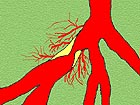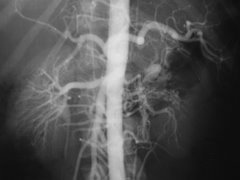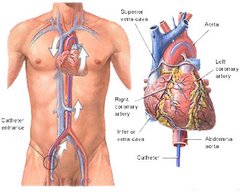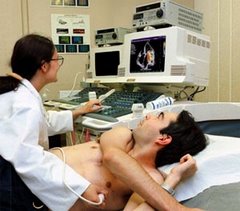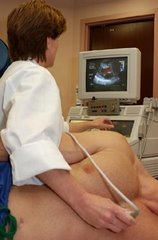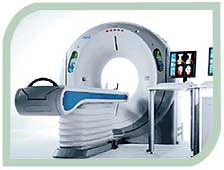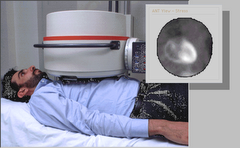- Explain to patients that this study compared optimal medical management versus stenting in patients with chronic stable angina. The findings did not extend to patients with acute coronary syndrome.
- Explain to patients that on the basis of current evidence, stenting does not reduce mortality or prevent myocardial infarctions in patients with chronic stable angina but it does provide rapid relief of symptoms.
Monday, April 09, 2007
What should doctors tell their patients about COURAGE?
Respect for COURAGE Study Coming
Now that the dust has started to settle, some believe the fallout might be less striking than implied by the uproar at the American College of Cardiology meeting here. When the COURAGE results were presented, interventional cardiologists and stent-makers perceived a bleak future.
Since then, even the interventional cardiologists have calmed down. Some joined medical cardiologists in pointing out that COURAGE and other recent studies may help put stenting into perspective for chronic stable angina, finding the right patient population.
Others argued that irrespective of the eventual impact, their lack of faith in stenting, at least for chronic stable angina, has been justified by COURAGE, in spades.
For example, Salim Yusuf, M.D., of McMaster University in Hamilton, Ontario, a medical cardiologist and blunt critic of percutaneous coronary interventions, said the trial confirmed that stenting has "very little to offer." Percutaneous coronary interventions "only have a role when medical therapy fails."
Noting that stenting has been touted for its ability to bring fast relief of angina, Dr. Yusuf suggested that stenting should be classified as palliative therapy while medical management and coronary artery bypass graft surgery should be considered therapeutic.
Steven Nissen, M.D., director of cardiovascular medicine at the Cleveland Clinic, said the real impact might be more of a course adjustment rather than a sea change.
Dr. Nissen, who was president of the ACC when the COURAGE results were reported at the ACC meeting, and published simultaneously online in the New England Journal of Medicine, said he is anticipating a modest impact on clinical practice.
Most clinicians, Dr. Nissen predicted, will now feel more comfortable about offering medical therapy as initial treatment, but "they will also recognize that the patient can at any time be crossed over to elective angioplasty."
But the findings do "remind us that intervening at a single spot does not change the underlying pathophysiology of coronary artery disease, which is that the next plaque that causes infarct won't be the plaque that was stented," he said. "It is not common to see an infarct at the point of high grade stenosis [which has been stented] but rather at another point where the stenosis may be much less-say 20% to 40%."
Sidney Smith, M.D., a professor of medicine at the University of North Carolina at Chapel Hill, said that the COURAGE trial was important because it "emphasized the value of comprehensive medical therapy, which is needed even for patients who do undergo percutaneous coronary intervention."
Dr. Smith added, "It's also important for us to explain to our patients that these findings in no way address the role-the very important role-of primary percutaneous coronary intervention in acute coronary syndrome, We shouldn't lose sight of the reality that revascularization can help patients in that emergency situation."
Gregory J. Dehmer, M.D., director of the division of cardiology at the Scott and White Clinic in Temple Tex., and a professor of medicine at Texas A&M College of Medicine, said that was exactly what happened during the initial rash of news reports about the COURAGE findings.
He said that interventional cardiologists were confronted with recently stented patients who pointed to stark headlines that declared "Most Angioplasty Unnecessary." The patients wanted to know if they fell into that "unnecessary" category. The concern, according to Dr. Dehmer, arose because most of the early news reports failed to clearly differentiate between chronic stable angina and acute coronary syndrome.
Dr. Dehmer, who is president of the Society for Cardiovascular Angiography and Interventions (SCAI), also pointed out that current guidelines recommend medical therapy as the initial treatment for chronic stable angina, so "this is really not new."
Dr. Smith, who chairs the ACC/American Heart Association/SCAI's percutaneous coronary intervention guidelines committee, agreed that the guidelines for treatment of chronic stable angina do not recommend percutaneous coronary intervention as an initial treatment. He declined to speculate about the impact -- if any -- of the COURAGE findings on future guidelines.
The COURAGE trial has frequently been characterized as a face-off between two subspecialties within cardiology -- the interventional cardiologists and the medical cardiologists.
But William E. Boden, M.D., of the University of Buffalo (N.Y.), COURAGE's principal investigator, has made a point of downplaying the turf battle potential of the trial.
During a press conference at the ACC meeting, he said it was a mistake to consider the trial as a competition between interventional and medical cardiologists, insisting instead that it was "an open-minded attempt to determine if there is an additional benefit of angioplasty on top of optimal medical therapy."
Moreover, Dr. Boden claimed that if bias existed in the trial, that bias would favor percutaneous coronary intervention because we "purposely set this up to give percutaneous coronary intervention the best opportunity to demonstrate benefit."
As a result, he said, he was "surprised by the results, especially by the really unexpected positive impact of medical therapy on symptomatic relief of angina -- at five years 74% of stent patients and 72% of the medical therapy patients were free of angina.
Dr. Dehmer said that he, too, was initially surprised by symptomatic benefit observed in the medical therapy arm, but after reflecting upon the study for more than a week he had a slightly different reaction.
The COURAGE trial, he said, demonstrated that just as catheter-based interventions have improved in the last decade, so has medical therapy. "This is evidence of just how good medical therapy has become," he said. At the same time he said there have been major technical advances in thoracic surgery so that coronary artery bypass surgery has also "become a less invasive procedure with less morbidity."
Taken together, those advances suggest that "we have a number of very good options to offer patients," Dr. Dehmer said.
Valentin Fuster, M.D., Ph.D., director of the Zena and Michael A. Wiener Cardiovascular Institute and a professor of medicine at Mount Sinai School of Medicine in New York, said the COURAGE findings "are not really surprising for any of us since medical therapy today is really quite different from medical therapy 10 or 20 years ago."
Drugs are more effective and better tolerated today, Dr. Fuster said, "which means that adherence to medical therapy is not the obstacle that it was considered to be in the past."
Beyond better drugs, Dr. Fuster said the COURAGE findings were predictable because "15 years ago trials comparing bypass surgery to medical therapy for patients with stable angina found no difference. This is the same story again."
Nonetheless, Dr. Fuster said he hoped the "not surprising" COURAGE findings would dampen enthusiasm for stenting. "The community has been mislead by the results of acute trials that have shown a definite benefit for primary percutaneous coronary intervention," he said. "Those benefits have been transferred -- wrongly -- to the chronic patients and that is where the community was misled."
Initially, leading interventional cardiologists and major stent-makers were aggressive in their criticism of COURAGE, as the results were presented at the ACC sessions.
They said that COURAGE had a flawed design on two counts. First, it didn't include angina relief as a primary endpoint. Second, although 97% of percutaneous coronary interventions in COURAGE involved bare-metal stents or balloon angioplasty, most of the stents implanted today are drug-eluting.
And they moved quickly to get this message out to journalists covering the ACC sessions.
Donald Baim, M.D., chief medical officer of Boston Scientific, a leading stent-maker, tried to persuade reporters to put a positive spin on the COURAGE data. He suggested that instead of a headline such as "Yet Another Failure of Percutaneous Coronary Intervention," the headline could be "Another Study Saying for Stable Angina You Have PCI to Improve Symptoms."
And moments after the ACC press conference on COURAGE began, David E. Kandzari, M.D., chief medical officer at Cordis Cardiology Division of Johnson & Johnson, which makes Cypher, a sirolimus-eluting coronary stent, made public a "Dear Colleague" letter critical of the results.
From 1999 through 2004, the COURAGE investigators recruited 2,287 patients who had stable angina at 50 U.S. and Canadian centers. They assigned 1,149 patients to percutaneous coronary intervention plus maximum medical therapy and 1,138 to maximum medical therapy alone.
After 4.6 years the primary event rate -- death and myocardial infarction -- was 19.0 in the percutaneous coronary intervention group versus 18.5% in the medical therapy arm, a statistical dead heat.
Among the non-significant differences in the findings:
- There were 211 primary events in the percutaneous coronary intervention arm and 202 in the medical therapy arm (NS).
- There were 85 deaths in the percutaneous coronary intervention arm included 23 cardiac deaths and 95, of which 25 were cardiac deaths in the medical therapy group (NS).
- There were 143 myocardial infarctions in the percutaneous coronary intervention group and 128 in the medical therapy arm (NS).
- There were 22 strokes in the percutaneous coronary intervention arm and 14 in the (NS).
There was a statistically significant difference in revascularization that favored percutaneous coronary intervention, 228 versus 348 (P<0.001).>
COURAGE was the third shoe to drop on interventional cardiology in the past year, so analysis of this study requires mention of those first two shoes.
At the 2006 ACC meeting and again at the 2006 European Society of Cardiology meeting, there were a number of reports that drug-eluting stents were associated with a small, but statistically significant increase in the risk of late stent thrombosis compared with bare metal stents. In some of those studies, including a number of European registries, there was also a small, late increase in both death and MI.
The concern about stent thrombosis and drug-eluting stents led the FDA to convene a special panel to review drug-eluting stent safety in December 2006. That panel found that when used according to label indications, meaning for low-risk patients with single-vessel disease, drug-eluting stents were safe.
Used off label, which is how about 60% of drug-eluting stents are used, the safety was not as clear cut, which led the panel to recommend that dual-antiplatelet therapy (aspirin plus clopidogrel [Plavix]) be extended for 12 months when the stents were used in higher risk patients. The FDA is also considering new requirements for future approvals of drug-eluting stents.
The other shoe that dropped was the Occluded Artery Trial (OAT), which found that when stenting was delayed for a day or two after an MI it did not reduce cardiovascular events compared with optimal medical therapy. The OAT results were reported in November at the American Heart Association meeting.
"I do think these trials [COURAGE and OAT] combined with the emerging issue of stent thrombosis risk remind us not to ascribe magical properties to interventions," Dr. Nissen said. "It seems so intuitive -- you have an 80% to 95% blockage, surely putting a stent in ought to make the patient a whole lot better."
But the reality, he said, is that stenting doesn't "really change the prognosis. I do think that we got into an era of irrational exuberance where we began to believe that no alternative was more effective than stenting -- especially stenting with a drug-eluting stent."
The events of the past 12 months, he said, remind physicians and patients of the "important principle that atherosclerotic disease is a systemic disease, there are plaques throughout the coronary, and any interventional procedure does not address the underlying pathophysiology. So putting a stent in the tightest narrowing is not going to change the outcome."
Dr. Dehmer said the events of the past year "reminds us that medicine is an incredibly dynamic field -- we're always learning new things about what we do. We've seen this over and over again. I reflect upon the vitamin E story -- vitamin E was promoting as the greatest thing, then another study found the net effect was no benefit. We've seen this with digoxin for heart failure: first it's good drug, then it's a bad drug, then it's a good drug over and over. And we are going to see this in many areas of medicine for many years to come."
As an interventional cardiologist, Dr. Dehmer said, "when I talk with patients I tell them I'm the interventionalist, I'm the guy you call when your house if on fire and something needs to be fixed, but if you really want to help yourself it's prevention, prevention, prevention. You need to control your blood pressure, get your cholesterol down, lose weight, exercise, get rid of those cigarettes."







